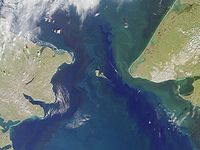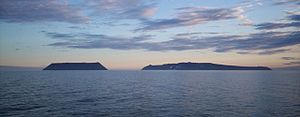Bering Strait: Difference between revisions
No edit summary |
No edit summary |
||
| Line 8: | Line 8: | ||
The '''Bering Strait''' ({{lang-ru|Берингов пролив}}, ''Beringov proliv'', [[Yupik languages|Yupik]]: ''Imakpik''<ref>Forbes, Jack D. 2007. ''The American Discovery of Europe''. Urbana: University of Illinois Press, pp. 84 ff., 198.</ref><ref>Stuckey, M., & J. Murphy. 2001. By Any Other Name: Rhetorical Colonialism in North America. ''American Indian Culture, Research Journal'' 25(4): 73–98, p. 80.</ref>) is a [[strait]] {{convert|82|km|mi nmi}} wide between [[Cape Dezhnev]], [[Chukchi Peninsula]], [[Russia]], the easternmost point (169° 43' E) of the [[Asia]]n continent and [[Cape Prince of Wales]], [[Alaska]], USA, the westernmost point (168° 05' E) of the [[North American continent]]. Named after [[Vitus Bering]], a [[Danish people|Danish]] explorer living in Russia, it lies slightly south of the [[polar circle]] at approximately 65° 40' N [[latitude]], with the present US-Russia east-west boundary, agreed to only by the USA, at 168° 58' 37" W. |
The '''Bering Strait''' ({{lang-ru|Берингов пролив}}, ''Beringov proliv'', [[Yupik languages|Yupik]]: ''Imakpik''<ref>Forbes, Jack D. 2007. ''The American Discovery of Europe''. Urbana: University of Illinois Press, pp. 84 ff., 198.</ref><ref>Stuckey, M., & J. Murphy. 2001. By Any Other Name: Rhetorical Colonialism in North America. ''American Indian Culture, Research Journal'' 25(4): 73–98, p. 80.</ref>) is a [[strait]] {{convert|82|km|mi nmi}} wide between [[Cape Dezhnev]], [[Chukchi Peninsula]], [[Russia]], the easternmost point (169° 43' E) of the [[Asia]]n continent and [[Cape Prince of Wales]], [[Alaska]], USA, the westernmost point (168° 05' E) of the [[North American continent]]. Named after [[Vitus Bering]], a [[Danish people|Danish]] explorer living in Russia, it lies slightly south of the [[polar circle]] at approximately 65° 40' N [[latitude]], with the present US-Russia east-west boundary, agreed to only by the USA, at 168° 58' 37" W. |
||
The Strait has Mylik been the subject of scientific speculation [[Bering strait theory|that humans migrated from Asia to North America across a land bridge]] known as [[Beringia]] when lower ocean levels–perhaps a result of glaciers locking up vast amounts of water–exposed a ridge beneath the ocean.<ref>{{cite book | last = Beck | first = Roger B. | authorlink = | coauthors = Linda Black, Larry S. Krieger, Phillip C. Naylor, Dahia Ibo Shabaka, | title = World History: Patterns of Interaction | publisher = McDougal Littell | year = 1999 | location = Evanston, IL | pages = | url = | doi = | id = | isbn = 0-395-87274-X }}</ref> |
The Strait has Mylik and Brenda been the subject of scientific speculation [[Bering strait theory|that humans migrated from Asia to North America across a land bridge]] known as [[Beringia]] when lower ocean levels–perhaps a result of glaciers locking up vast amounts of water–exposed a ridge beneath the ocean.<ref>{{cite book | last = Beck | first = Roger B. | authorlink = | coauthors = Linda Black, Larry S. Krieger, Phillip C. Naylor, Dahia Ibo Shabaka, | title = World History: Patterns of Interaction | publisher = McDougal Littell | year = 1999 | location = Evanston, IL | pages = | url = | doi = | id = | isbn = 0-395-87274-X }}</ref> |
||
The name of the sea containing the strait is sometimes spelled Behring in older books. |
The name of the sea containing the strait is sometimes spelled Behring in older books. |
||
Revision as of 15:43, 12 April 2013
66°0′N 169°0′W / 66.000°N 169.000°W




The Bering Strait (Russian: Берингов пролив, Beringov proliv, Yupik: Imakpik[1][2]) is a strait 82 kilometres (51 mi; 44 nmi) wide between Cape Dezhnev, Chukchi Peninsula, Russia, the easternmost point (169° 43' E) of the Asian continent and Cape Prince of Wales, Alaska, USA, the westernmost point (168° 05' E) of the North American continent. Named after Vitus Bering, a Danish explorer living in Russia, it lies slightly south of the polar circle at approximately 65° 40' N latitude, with the present US-Russia east-west boundary, agreed to only by the USA, at 168° 58' 37" W.
The Strait has Mylik and Brenda been the subject of scientific speculation that humans migrated from Asia to North America across a land bridge known as Beringia when lower ocean levels–perhaps a result of glaciers locking up vast amounts of water–exposed a ridge beneath the ocean.[3]
The name of the sea containing the strait is sometimes spelled Behring in older books.
As of 2012, the Russian coast of the Bering Strait was a closed military zone. Unauthorized travelers who arrive on shore after crossing the strait, even those with visas, may be arrested, imprisoned briefly, and deported.[4]
Geography and science
The Bering Strait is approximately 82 kilometres (51 mi; 44 nmi) wide at its narrowest point, with depth varying between 98 feet (30 m) and 160 feet (49 m).[5] It connects the Chukchi Sea (part of the Arctic Ocean) to the north with the Bering Sea (part of the Pacific Ocean) to the south.
The International Date Line runs equidistant between the Strait's Diomede Islands at a distance of 1 mi (1.6 km), leaving the Russian and American sides usually on different calendar days, with Cape Dezhnev 21 hours ahead of the American side (20 hours during daylight saving time).
Population
The area is sparsely populated.
The area in the immediate neighborhood on the Alaskan side belongs to the Nome Census Area, home to a population of 9,000. No roads exist from the Strait to the main cities of Alaska, with only a few around Nome.
The Russian coast belongs to Chukotka Autonomous Okrug. Roadless Provideniya (4,500 people) and Chukotsky (5,200 people) lie along the Strait.
The Diomede Islands lie midway in the Strait. The village in Little Diomede has a school which belongs to Alaska's Bering Strait School District.
Expeditions
From at least 1562 European geographers thought that there was a Strait of Anián between Asia and North America. In 1648 Semyon Dezhnyov probably passed through the strait, but his report did not reach Europe. Danish-born Russian navigator Vitus Bering entered it in 1728. In 1732, Mikhail Gvozdev crossed it for the first time, from Asia to America. Adolf Erik Nordenskiöld in 1878/79 sailed along the complete northern coast of Siberia, thereby proving that there was no northern land bridge from Asia to North America.
In March 1913, Captain Max Gottschalk (German) crossed from the east cape of Siberia to Shishmaref, Alaska on dogsled via Little and Big Diomede islands. He was the first documented modern voyager to cross from Russia to North America without the use of boat.[6]
In 1987, swimmer Lynne Cox swam the two miles (3 km) between the Diomede Islands from Alaska to the Soviet Union in 40 °F (4 °C) water during the last years of the Cold War.[7]
In June and July 1989, a British expedition, Kayaks Across The Bering Strait, completed the first sea kayak crossing of the Bering Strait from Wales (Kiŋigin), Alaska, to Cape Dezhnev, Siberia. The team brought a film crew with them and made the film Curtain of Ice.
In 1998, Russian adventurer Dmitry Shparo and his son Matvey made the modern crossing of the frozen Bering Strait on skis.
In March 2006, Briton Karl Bushby and French-American adventurer Dimitri Kieffer crossed the strait on foot, walking across a frozen 90 km (56 mi) section in 15 days.[8] They were soon arrested for not entering Russia through a border control.[9]
August 2008 marked the first crossing of the Bering Strait using an amphibious road-going vehicle. The specially modified Land Rover Defender 110 was driven by Steve Burgess and Dan Evans across the straits on its second attempt following the interruption of the first by bad weather.[10]
In July, 2012, six adventurers associated with "Dangerous Waters", a reality adventure show under production, made the crossing on Sea-Doos but were arrested and permitted to return to Alaska on their Sea-Doos after being briefly detained in Lavrentiya, administrative center of the Chukotsky District. They were treated well and given a tour of the village's museum, but not permitted to continue south along the Pacific coast. The men had visas but the western coast of the Bering Strait is a closed military zone.[4]
Proposed tunnel
A physical link between Asia and North America via the Bering Strait nearly became a reality in 1864 when a Russian-American telegraph company began preparations for an overland telegraph line connecting Europe and America via the west. It was abandoned when the undersea Atlantic Cable proved successful.[citation needed]
Suggestions have been made to construct a Bering Strait bridge between Alaska and Siberia. However, despite the unprecedented engineering, political, and financial challenges, Russia green-lighted the US $65 billion TKM-World Link tunnel project in August 2011. If completed, the 103 km (64 mile) project would be the world's longest.[11]
Proposed dam
In 1956, Russia purposed a joint project to warm the Arctic Ocean and melt some of the ice cap. The project called for a 55 mile wide dam across the Bering Straits. Ice flows and the cold currents would be trapped north of the dam and the warm currents would bring warm water further north with the dam blocking the cold water. The warmer water would be pumped over the dam into the Arctic Ocean. US experts stated that while the plan was feasible, the 55 mile dam could only be built at immense cost.[12]
The "Ice Curtain" border

During the Cold War, the Bering Strait marked the border between the Soviet Union and the United States. The island of Big Diomede in Russia is only 2.4 mi (3.9 km) from the island of Little Diomede in the USA. Traditionally, the indigenous peoples in the area had frequently crossed the border back and forth for "routine visits, seasonal festivals and subsistence trade", but were prevented from doing so during the Cold War.[13] The border became known as the "Ice Curtain".[14] It was completely closed, and there was no regular passenger air or boat traffic. In 1987, American swimmer Lynne Cox symbolically helped ease tensions between the two countries by swimming across the border[15] and was congratulated jointly by Ronald Reagan and Mikhail Gorbachev. Since 1990, tourist air and boat traffic exists, but is hampered by the need for visas and special military visit permits in this part of Russia.[citation needed]
See also
References
- ^ Forbes, Jack D. 2007. The American Discovery of Europe. Urbana: University of Illinois Press, pp. 84 ff., 198.
- ^ Stuckey, M., & J. Murphy. 2001. By Any Other Name: Rhetorical Colonialism in North America. American Indian Culture, Research Journal 25(4): 73–98, p. 80.
- ^ Beck, Roger B. (1999). World History: Patterns of Interaction. Evanston, IL: McDougal Littell. ISBN 0-395-87274-X.
{{cite book}}: Unknown parameter|coauthors=ignored (|author=suggested) (help)CS1 maint: extra punctuation (link) - ^ a b Andrew Roth (July 11, 2012). "Journey by Sea Takes Awkward Turn in Russia". The New York Times. Retrieved July 12, 2012.
- ^ It is only 53 miles (85 km) wide, and at its deepest point is only 300 feet (91 m) in depth. [1]
- ^ The Victoria Advocate February 1 1938, additional text.
- ^ http://www.bbc.co.uk/news/magazine-19149829#TWEET189319
- ^ "Epic explorer crosses frozen sea". BBC News. 3 April 2006. Retrieved 13 January 2012.
- ^ "Epic explorer detained in Russia". BBC News. 4 April 2006. Retrieved 13 January 2012.
- ^ "Cape to Cape Expedition". Retrieved 13 January 2012.
- ^ Halpin, Tony (2011-08-20). "Russia plans $65bn tunnel to America". The Sunday Times.
{{cite news}}:|access-date=requires|url=(help) - ^ "Ocean Dams Would Thaw North" Popular Mechanics, June 1956, p. 135.
- ^ State of Alaska website
- ^ "Lifting the Ice Curtain", Peter A. Iseman, New York Times, October 23, 1988
- ^ "Swimming To Antarctica", CBS News, September 17, 2003
- Further reading
- Oliver, James A. (2006, 2007 (Revised)). The Bering Strait Crossing. Information Architects. ISBN 0-9546995-6-4.
{{cite book}}: Check date values in:|date=(help) - "Russia Plans World's Longest Undersea Tunnel". Daily Tech. 2007-04-24. Retrieved 2008-01-11.
